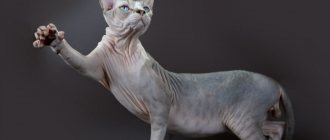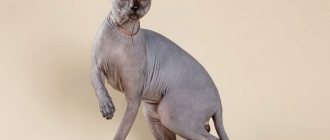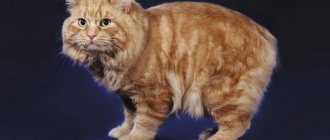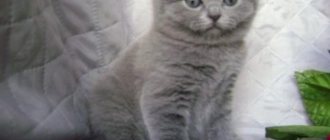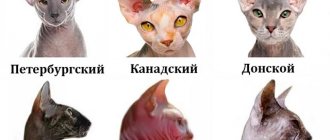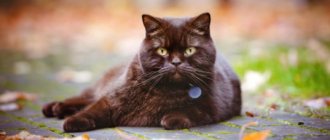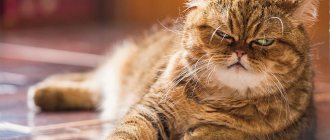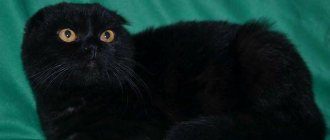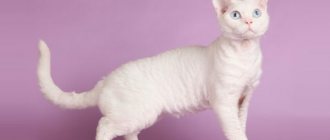Hairy Sphynxes with fur are cuties that bring a special atmosphere to every home. Contrary to the prevailing stereotype, sphinxes are not only bald! Hairy cuties have an equally exotic look and are suitable for those who like to stroke their cat's fur, but don't want fur flying everywhere.
They have coarse hair and an incredibly affectionate nature. This breed is also called Don or Russian, because it appeared in Russia in the ninety-sixth year of the last century. She appeared like this: in Rostov, a woman found a cat named Varvara on the street, she took her home and began to care for her, but she gradually became bald. The treatment did not help, and one day she gave birth to kittens from a European cat. One of them marked the beginning of a variety of hairless animals, which appeared thanks to the felinologist I. Nemykina. But you can’t cross them with each other, so there are hairy brush animals with sparse and curly fur.
Features and habits of the Sphynx Brush cat
Cats without hair are no longer considered a novelty, and it is no longer possible to surprise with them. Modern breeds of such cats make many people smile and want to touch their skin and stroke them. The Sphynx Brush is a cat with little fur on its body - the hair is short and sparse, more like fluff.
Read also: Why you can’t live in the past?
Don Sphynx brush.
Dimensions and parameters
Don Sphynxes are medium-sized breeds. Their height on average is 25-30 cm at the withers. The cats look much larger and more powerful than the thin, graceful cats.
The weight of a female sphinx is 3.5-5 kg; male – 5-7 kg. Owners should remember that neutered pets gain weight faster; they need to be careful to ensure that the cat does not overeat and moves more.
The body temperature of Don Sphynxes ranges from 38.0–39.5°C. Due to the fact that they have no hair, when you touch the skin, the cat seems to be hot.
pros
Many owners note the friendly and easy-going nature of Sphynx cats with fur. Cats of this breed have the following advantages:
Read also: Feeling bad after eating
- lack of aggression;
- high intelligence;
- learning ability;
- good harmony with other species of animals;
- pickiness in food;
- cleanliness.
In addition, Sphynx cats with fur are considered healing cats. They have increased heat exchange, and the surface of the hair always remains hot. These animals can be used as living heating pads. They are extremely affectionate and love to cuddle up to the human body.
Choosing a kitten
Don Sphynx kittens are very demanding to care for. Therefore, it is recommended to take them from a nursery. This method guarantees the new owner that the animal will have all its vaccinations and will be healthy and physically fit for its age.
Experienced breeders do not recommend purchasing a kitten until it is three months old. It is important to pay attention that he is playful and good at communicating. It is necessary to carefully examine the baby's ears and eyes to ensure that there are no foreign secretions or hardened crusts.
Particular attention should be paid to examining the kitten's skin. If there is a gray coating on it, this indicates that the animal was kept in poor conditions.
Don Sphynx kittens photo:
Breed cost
The price for a Don Sphynx, which has a pedigree and all documents, can range from 10,000 to 30,000 rubles . Before purchasing, it is recommended to carefully study all documents and check the veterinary passport with vaccinations.
this breed about the breed except sphinx breed in general
rodentsonemeauthorcontentsharevideoresponsebluebackfacebook
Flock
Newborn kittens may appear hairless. But upon closer examination, you can notice sparse hairs no more than 2 mm long on the skin. The Sphynx flock has wool that resembles velvet in its structure. It covers the entire body of the animal.
The short coat persists only in childhood and young adulthood. As the animal grows, the hairs gradually become thinner and then disappear altogether. By about 2 years of age, cats become completely hairless.
Origin story
The official ancestor of this breed is a cat that was rescued in 1987 from the hands of street hooligans. This was a respectable act done by professor of the Pedagogical Institute E. Kovalev. This animal does not have hair on certain parts of the body. Soon she became completely bald. Veterinarians and the cat's owner explained this by shock or the consequences of a previous illness. After some time, the cat gave birth to new kittens, which initially looked like their mother. These kittens were mistakenly recognized as sick and for this reason they were killed, except for one.
Canadian Sphynx
This cat breed is never completely naked. Sphynx kittens are not born hairless. Their hairline resembles suede. In adulthood, hair remains on the nose, behind the ears, as well as on the paws and tail. It looks like thin twisted fibers. The Canadian Sphynxes have all of the above varieties of coat.
Reasons for the presence of fur in sphinxes:
The breed is not purebred . If someone from their parents (and in general, in the family) was not hairless, perhaps their genes played a role. Sometimes it even happens that unscrupulous breeders shave such kittens and pass them off as “pure” Sphynx cats. Hormonal imbalances . There have been cases when, after castration or sterilization, the Sphynx's fur began to grow.
Let your favorite Sphynx cat be naked!
More information on Why was the Sphynx born with fur?
You can receive by leaving a comment.
Source
Differences between the Canadian and Don Sphynx
Cats without fur, with a lot of folds, look like aliens. They are all called Sphynxes, and not everyone knows that this breed has its own species that differ from each other. Canadian and Don Sphynxes have the following differences:
- species have different baldness genes (dominant and recessive);
- Canadian Sphynxes are always covered with barely noticeable fluff, and Don Sphynxes can be completely hairless (“rubber”);
- Canadian individuals are endowed with large round eyes, while Don individuals have an almond-shaped eye shape;
- Canadians have no mustache at all;
- in the Don species, the tail is of medium length and thickness, straight and rather strong, in contrast to the Canadians, whose tail is weak, thin and pointed at the end;
- Don individuals have a strong torso and a strong muscular system, in contrast to the underdeveloped muscles of Canadians.
Why was the Sphynx born with fur?
Sometimes, new owners of Sphynx kittens are concerned with the question of why their Sphynx was born with fur and whether it is likely that he will go bald and become a full-fledged representative of his breed?
Firstly, there is no need to “panic” ahead of time. Having fur in kittens can be completely normal.
For example, among the Don Sphynxes, three varieties can be distinguished: brush, velor and bare-born. With the exception of bareborns, who have no hair or whiskers at all (read about the reason for the lack of whiskers in sphinxes in the article “Why sphinxes do not have whiskers”), kittens have short hair, which they lose as they grow up to one year.
The brush (from English “Brush” - “brush”) is characterized by the presence of short, hard wool, which is often compared to felt boots. Velor kittens can be born with fluff.
As a rule, the fur sheds over time, but may remain on the paws, tail and head.
During the cold season there may be more wool.
Rules of care
These cats do not need serious care:
- Sphynx Brush cats are fed natural or premium dry food. Also, the cat’s body constantly needs a large amount of fluid and properly selected vitamins.
- Don't forget that the Sphynx Brush's ears and teeth need regular cleaning. Optimally - once a week.
- Brush cats need to be bathed regularly. You can buy a special product or take a good baby shampoo.
- Cats don't have eyelashes, so pay attention to their eyes. This is especially true for kittens - it is better to wipe their eyes with a damp, clean swab once a day.
Important! The hair of a plush Sphynx can change due to a new diet, temperature, humidity in the room, changes in hormonal levels during gestation or estrus.
Why do sphinxes have fur?
The appearance of new hair on an animal of this breed, or, conversely, its disappearance after the woolly kittens grow up, is associated with many factors. There will be no clear answer. The reasons may be the following:
- The appearance of hairiness is sometimes influenced by vaccinations; hormonal manifestations of the individual associated with bearing kittens; unsuccessful selection of feed; weather; castration.
If a litter has ideal parents, but one of the kittens was still born with hair, do not forget that he had great-grandparents who gave the baby hair.
In the end, the lack of fur only reduces the price of a kitten, but does not in any way affect its character, which is sweet and good-natured, like all sphinxes.
Skin care and bathing
The Sphynx breed, due to its physiological characteristics, needs more frequent bathing than their furry counterparts. This procedure must be done correctly so that the cat does not experience stress and avoid health problems. It is better to do this in a shallow container or bath; the depth of the water should not exceed 15 cm. Cats are often frightened by the stream of flowing water.
It is recommended to use special care formulations or products for children as shampoo. They do not contain harsh ingredients that can cause irritation, and this breed has very sensitive skin.
Sphynx dogs have a high temperature, so they need to be washed with preheated water. The optimal temperature should be 36-39 degrees. When washing an animal, you need to calmly talk to it and stroke it so that the animal remains calm and does not get nervous. The amount of shampoo depends on the degree of soiling of the cat.
Table describing care procedures for Sphynx cats.
In some cases, you can do without it altogether by simply bathing it in warm water. When bathing, water should not get into the animal's ears, as this can lead to inflammatory processes. In this case, it is not recommended to wash your hair at all; you can use wet wipes.
It is not recommended to wash kittens that have recently been given a new home and have not yet had time to adapt to their new living conditions. The Sphynx should be bathed at least once every ten days. After bathing, the animal should be thoroughly dried and the room should be warm. Otherwise, the cat may catch a cold.
Sphynx kitten at six months.
Content Features
Many people get hairless cats in order to avoid endless combing and cleaning up fluff throughout the apartment. But, alas, sphinxes are far from the easiest breed to keep. If you want your pet to be in excellent shape and in a good mood, you will have to constantly spend a lot of money and time for this. And here’s a paradox: the less fur a cat has, the more expensive its beauty requires. In this sense, velor is the optimal coating option.
To wash or not to wash?
These amazing cats are special in everything - and in their care too. They are neat and very clean, but their own washing is still not enough; the owner must help the pet care for sensitive skin so that irritation and dermatological diseases that hairless animals are prone to do not occur. Mandatory hygiene for sphinxes has much in common, but there are also differences - depending on the type of coat.
All sphinxes are amazingly clean
All cats of this breed group “sweat”: their sebaceous glands secrete a special lubricant that cannot be distributed throughout the fur and remains on the skin. Without such natural nourishment, the skin will dry out and begin to peel. As soon as, while stroking your pet, you notice that your palm is dirty, it’s time to arrange a bath day.
Starting from the age of two months, “rubber” Sphynx cats are bathed weekly, using only special shampoos for hairless cats. Such frequent washing usually does not irritate the delicate skin and does not provoke allergies.
But you can also use other cleaning products, for example, special cat wipes. Velor cats can be bathed less often - once or twice a month as they become dirty - and you can also wipe off dust and dirt adhering to the skin with napkins - especially a lot of it collects in the groin and armpits. Too frequent bathing is not beneficial for any cat, including a hairless one. Remember also that cosmetics (creams, gels, lotions and conditioners) are suitable for sphinxes only with a certain acidity - with a pH of 3.8 to 4.5.
Hairless cats love to splash in warm water
The tail requires special care, the sebaceous glands on which are often clogged, inflamed, and covered with black dots - acne. To prevent this from happening, the tail should be washed with special products more often than the entire cat. The large eyes and huge ears of sphinxes also come into the area of increased attention - they must be kept clean so that there is no risk of infection. Like all cats, you need to monitor the condition of the teeth and claws of “baldy cats”.
Warm and satisfying
Warmth is the main condition for the happiness and health of any Sphynx. In the house where he lives, cold and drafts must be strictly prohibited. Warm beds, cozy clothes made of soft fabrics without seams - all this is included in the mandatory arsenal of the sphinx owner. If you do not provide the animal with a comfortable temperature, it will try to warm up near heating devices, where it can get skin burns. Also, exposure to direct sunlight often results in burns.
These cats always want to stay warm
Hairless cats that are always freezing are characterized by an accelerated metabolism and, as a result, an increased appetite. It is very important to correctly maintain a balance between the quantity and quality of food in the daily diet of such animals. Only practitioners with extensive experience can create a menu of natural products, so breeders usually recommend that those who get Sphynx dogs for the first time select ready-made food based on the tastes, health, and individual characteristics of their pet.
The following are considered the best ready-made food for sphinxes:
- Orijen Cat & Kitten (Canada) – holistic food;
- ACANA Grasslands for Cats (Canada) – holistic food;
- Purina Pro Plan Delicate (France) – super-premium;
- Royal Canin Sphynx Adult (USA, France) – premium class;
- Hill's Science Plan Adult Lamb (USA) – premium food.
The excellent condition of the skin and coat of your velor beauty is an unmistakable signal that the feeding regimen and menu have been chosen correctly. Pay special attention to the diet of sterilized animals.
A properly selected diet is very important for the Sphynx
As for breeding hairless cats, it is better to leave this complex topic to the professionals. Breeding work with all breeds of sphinxes is not only practice, but also a real science in which, alas, there are fewer discoveries than disappointments.
Finding a parent pair of sphinxes is not an easy task.
Character and special habits of brushes
These cats can be characterized as playful and inquisitive. Over time, they become full-fledged members of the family. They choose one master or favorite for themselves, they always obey him unquestioningly, carrying out all his commands. They treat other people with warmth and good nature. Also, the Sphynx Brush is intelligent, but tends to be touchy. However, he is not vindictive. You should not punish this animal physically and psychologically.
Brushes can be called empaths, capable of sensing changes in a person’s mood. They react to this, trying to pity and cheer up the person. Cats love affection, all kinds of manifestations of tenderness, care, and attention to themselves. This breed is characterized by quickly getting used to a new place, observing all the requirements that the owners place on them. If the animal refuses to visit the tray assigned to it, you just need to move it to another place.
Sphynx kittens.
Reviews
All owners of such tailed animals are very happy with them, it is impossible not to fall in love with them; as a rule, such pets become loved by all family members, even if someone is initially put off by their appearance. Cats of this variety are disciplined, easy to train and raise, and love to be photographed.
They are loyal and love their owners, meeting them at the doorstep and following them around the house everywhere. They often sleep in bed with people, love to purr on their knees and sleep in the warmth of human hugs.
To read: Chocolate Havana: origin of the breed, care recommendations
Some take in adult animals, and they still quickly adapt to the new environment. They love children and easily find a common language with other representatives of the animal world. They do not spoil wallpaper and furniture, especially if you accustom them to scratching posts from childhood. They always go to the toilet in the litter box. The only thing that can be a problem for busy people is daily wiping, but for those who are already used to it, caring for a cat is a pleasure.
Petersburg brush (Peterbald)
Russian breed, in the selection of which Don cats took part. Just like their predecessors, these sphinxes are covered with curly hair and some of them remain in this form for the rest of their lives. The second half “undresses” not completely. In adult cats, dense growth is observed on the face, tail and may be on the paws. This option is called brush point due to the characteristic location of the hair at the ends of the body.
Suitable age for mating Sphynx
Puberty in Sphynx girls occurs at the age of 6–8 months. Hairless boys mature a little later (8–9 months), and by one year both sexes are guaranteed to become full-fledged individuals in terms of ability to reproduce.
But the mating rules also take into account the formation of physical qualities. And they are completely completed only by one year in cats and by one and a half in males. Before this age, mating a Sphynx for the first time is strictly not recommended. Due to physical immaturity, the cat is not able to conceive full-fledged offspring, and the cat’s body cannot cope with bearing and feeding kittens.
When breeding Sphynxes, breeders are guided by the number of heats that have passed since entering the sexually mature stage. It is considered normal for a cat to mate in the third cycle. By this time, the sexual health of the sphinx was fully formed, strengthened, and reached a level acceptable for successful motherhood.
Changes in the behavior of sphinxes date back to this time:
- Cats in heat persistently look for a partner - they crouch, arch, scream, can show aggression, or become unusually affectionate.
- Cats mark territory.
Apart from the age of first mating, there are no other physiological restrictions. But experts recommend paying attention to other details:
- 2 weeks before the scheduled mating date, the sphinxes need to be given all vaccinations and anti-parasitic treatments. It is better if these events take place in advance, the partners’ bodies will work out the subsequent painful reaction and return to normal.
- There should be no pockets of infection, lacrimation, open wounds or other similar phenomena that interfere with mating.
- Sphinxes have their claws trimmed. During mating, signs of aggression may appear, and cats inflict deep scratches on each other. This happens quite often when mating for the first time.
- Before mating, sphinxes do not need to be bathed - this disrupts their natural scent and temporarily distracts them from their main task.
- A week before the scheduled mating date, stop giving your sphinx medications. Hormonal drugs are at risk.
Mating the Canadian Sphynx involves virtually no restrictions in the selection of partners in its group. They all interbreed well and give birth to healthy kittens without genetic consequences. Mating pairs of Sphynxes of the Don breed have some additional conditions that are associated with the presence in the population of residual manifestations of fur of varying degrees of intensity.
Important! At the preliminary stage of preparation for mating sphinxes, it is important not to miss another technical point - to obtain permission from the felinological club, so that in the future the kittens will have official documents corresponding to their breed.
Hairless Sphynx cat: character
The unique character of the Sphynx, as well as their appearance, is the result of careful selection. These animals are not prone to displaying aggression or discontent. Kind, soft, sensitive, gentle, devoted Sphynxes are ideal pets.
They get along well with both older people and families with small children. A balanced character combined with a playful disposition helps these animals share the interests of each family member.
Sphynx cats get along well in families with small children.
IMPORTANT: Sphinxes are not vindictive, they quickly forget random insults, but they have a hard time experiencing loneliness.
Sphynxes love to interact with people and pets. They are not afraid of large dogs and lack the hunter's instinct, so a hairless cat's best friend can be a huge bulldog, a hamster or a parrot.
Sphynxes are playful and curious animals
Character
These cats are very curious and playful, they love to communicate, love to be looked at and played with. They quickly adapt to a new home and can easily cope with moving. They trust people, become very attached to their owner, and are loyal to him, like dogs. They accompany “their” person everywhere and do not leave him a single step. It is important for them to sleep on their owner’s lap or next to them in order to feel protected and loved.
Kids of this breed are extremely energetic, they are friendly and joyful, they often play pranks, chase each other, swing on curtains and adore their pets like their parents.
Cats often get cold both at home and outside, so they often sleep under a blanket. In winter they sit near the radiators, and in summer they bask in the sun. It happens that they even get a sunburn, their skin begins to peel off and come off in flakes.
Adult creatures are calm, love to sit on the windowsill and look at birds and passers-by. They get along well with children and other animals. It is better not to leave them alone for a long time; this can make the creature’s character aggressive, because it yearns for loneliness. Therefore, it is better to choose a different type if you are at work for a long time and there is no one at home. Another option is to get two cats, then they won’t get bored. They quickly get used to the tray, are clean and tidy.
Sphinxes are easy to offend, so you should treat them delicately, it’s better not to even raise your voice, because after screaming, your pet can sit in the corner for hours and remember the offense. He listens to his owner, follows his commands and tries to please him with his behavior.
He is calm and devoid of aggression, loves children and does not misbehave. He loves to play with children, allows himself to be dressed, wrapped in blankets, and painted. Will never scratch or bite. The Sphinx eats funny, he takes the tasty treat with his paw and puts it in his mouth, and opens his mouth to its full width over the bowl.
Health and disease of the Brush Sphynx
Once every three months, the cat needs to be prevented from worms, and revaccinated once a year, according to the recommendations of veterinarians. One of the most common problems these animals face is diseases associated with the skin - dermatitis, irritation, rashes, etc. Congenital pathologies are rare in this breed, but they can acquire diseases that are more characteristic of them.
- Microphthalmos. A congenital pathology of the eyelids, in which the eyeball is smaller or underdeveloped, which can cause poor vision or complete blindness. The reasons for this have not been fully identified and are only being studied. With this pathology, veterinarians simply remove the damaged eye and, if possible, perform plastic surgery.
- Short lower jaw. Most often, this pathology occurs among Donetsk residents. In this case, an incorrect bite occurs, the jaws come into contact with each other and do not completely align.
- Turning of the eyelids. Characterized by weakening of the muscles of the eyelid ligaments. Solved surgically.
- Dermatitis. Type of skin disease.
- Nipple hyperplasia. It is often transmitted genetically through the female line. The risk group includes females with light blue tones.
- Trichophytosis. The type of fungal disease is similar to lichen.
The breed is distinguished by its strong health. If you follow proper care, a balanced diet, contact veterinarians on time and get all the necessary vaccinations, your pet will be a joy for a long time. They rarely get sick, thereby causing their owners trouble and expense.
Health
The lifespan of Sphinxes depends on the conditions of their detention and proper care for them. The average period is 12-15 years. The first Canadian Sphynxes are long-lived. The epidermis crossed the 16-year mark, and Bambi, who did not participate in the selection, lived to be 19 years old. The Sphynx Granpa Rexs Allen, crossed with a Devon Rex, became a record holder. His life lasted 30 years, 12 of which were spent at exhibitions.
Sphinxes have been shown to be prone to the following diseases:
- shortening of the lower jaw, developing due to premature ossification of the mandibular bone. The pathology is accompanied by dwarfism and hypothyroidism. In rare cases, leads to starvation and death;
- abnormal eye development. Rubber kittens are born with their eyes open, so they often experience keratitis. Sometimes under-opening of the palpebral fissure is detected, which requires plastic surgery;
- congenital entropion of the eyelids also requires surgical intervention. A predisposing factor in Sphinxes is abundant folds around the eye sockets and on the eyelids;
- a curved tail is a defective sign that prohibits the use of pets for breeding. When offspring appear, additional anomalies are identified in babies that threaten viability;
- acne (comedones and cystic acne). It occurs due to excessive sebum secretion and inflammatory processes. Requires careful skin care, treatment, and avoidance of sunlight. In the severe stage, castration is recommended;
- skin vasculitis;
- underdevelopment of the thymus or kitten sleep syndrome. Happens frequently. Naked babies are delayed in development and die in the first weeks after birth. An active baby may suddenly “fall asleep” and never wake up.
Don Sphynx and Peterbald
The Don Sphynx is a relatively young breed of cat with strong bones, well-developed muscles, and silky skin that is pleasant to human hands. The structural features that distinguish the appearance of hairless cats include:
- Graceful, straight back.
- Thin paws with a rounded shape and elongated toes.
- Smooth tail of medium length.
- Wedge-shaped skull with a flat forehead and clearly defined cheekbones.
- Pronounced cheek vibrissae.
- The ears are round and set high.
- The eyes can be of any color, the cut should be almond-shaped or oval.
- The presence of inconspicuous fluff on the body or its complete absence.
Subsequent attempts at selection gave rise to new types of sphinxes - Peterbald and Donskoy sphinx brush. The presence of a mutation in the genotype of the dominant Hbl allele provides for an early degree of baldness.
With the onset of cat maturity, hair loss increases and by the age of two, domestic cats acquire a fully formed appearance. According to the main criteria, these representatives of this breed are similar, but there are slight differences in appearance.
Naked, bald
Born with a complete absence of fur and tactile antennae-hairs, Sphynx cat kittens are born with open eyes, and the further color of the offspring can be easily determined by the pads of their paws.
The history of breeding velor sphinxes
All types of hairlessness of the Don and St. Petersburg Sphynxes are based on the dominant Hbl gene, which determines the main characteristics of these breeds and their breeding. Velor wool covering is one of the most popular - it looks impressive and does not create big problems in maintenance.
Velor Sphynx kitten is an incredibly charming creature
Don Sphynx velor
The Varvara cat, with whom the Don Sphynx breed is believed to have begun, was velor-point according to the modern classification of coat and blue-cream “tortoise” according to the color type. This strange kitten was taken from the boys on the street by Rostov resident Elena Kovaleva in 1986 - and at that very moment she entered the history of felinology. She was very sorry for the “shabby” baby and tried to fatten her and cure her. The cat grew up and felt great, but there was even less hair on her.
Varvara's children also had a velor covering; a baby named Chita attracted the attention of Elena’s friend Irina Nemykina, who later became the founder of the Don Sphynx breed, making titanic efforts to develop and recognize it. The new breed was recognized by the WCF in 1998, after which it received recognition from other felinological organizations around the world. Until 2000, matings with Siberian and European shorthair cats were allowed.
This is what the modern Don Sphynx looks like
The Donchaks have several breed standards, the differences of which are insignificant. Velor Don Sphynxes are characterized by hot, wrinkled skin with a delicate coat of hair that creates a small collar around the head. Young animals may have excessive hair. In winter, the growth also increases. The vibrissae are convoluted and break off easily.
The WCF and SFF standards allow all colors, while the IFF standard prohibits lilac and chocolate. The colors of the eyes, nose and fingertips should be in harmony with the main color.
Velor Peterbald
In the group of sphinxes, this breed is the youngest; it was the result of interbreeding of Donchak with Orientals, which gave its representatives a unique appearance. The first experimental mating took place in 1994, and the offspring lived up to the wildest hopes - excellent material was obtained for further selection. Today, interbreed matings between St. Petersburg and Don Sphynxes are prohibited. The breed received international recognition from the WCF in 2003.
The Peterbald's elegant appearance contributes greatly to its popularity.
The WCF standard allows any colors for St. Petersburg Sphynxes, but the preferred eye color is green, and in color-point varieties - blue. The skin of a velor Peterbald is flexible, very delicate, the quality of wool velor is the same as that of the Don Chaks; The presence of vibrissae is highly desirable. The color of the finger pads and nose should be in harmony with the main color.
Description of the breed
The appearance of these animals is unusual - they have hard hair on their muzzle and paws, and the same on their tail. Sometimes there are specimens in which fur grows exclusively on the legs and the body is bald. Here are the distinctive features of all these animals:
- The fur is coarse, slightly curly. As a rule, babies are born with normal fur, and only then does it thin out. In the fall, many people grow longer hair - they are insulated for winter - and in the spring everything falls out, only the paws and tail remain hairy.
- They have no eyebrows, their skin is velvety, like velor, their mustache may be either absent or curly.
- The eyes are angled and oval.
- The back is strong, muscular, straight, the tail is also straight, the limbs are of medium length, thin, graceful, strong, the fingers also seem elongated.
- The tail is thin and elongated, rounded at the end.
- The head is wedge-shaped, the cheekbones and brow ridges are clearly visible.
- The muzzle is medium, the nose is without depressions or humps, the chin is small, the ears are large.
- The colors vary. The most common species are white, blue, red, black and sometimes lilac.
- The size is usually small, but there are also large cats.
- The skin is soft and wrinkled, elastic, and there are wrinkles on the head, tail, paws, neck and belly.
- There is no musky smell, males rarely mark territory.
- Females are smaller, they have a narrower chest, thin neck and small head. The weight of the animal is three to five kilograms.
- The lifespan of the animal is twelve to fifteen years.
- Babies' eyes open a few hours after birth.
There are three subtypes of hairy sphinxes:
- velor, whose hairs are sparse, short and dense,
- point, distinguished by velor hairs on the body and curly, short, coarse hair on the paws, tail and muzzle,
- dense, with hard and frequent fur, through which the body cannot be seen.
Types of Sphynx coats
Brush animals were not bred on purpose - they appeared as a result of a gene mutation after crossing different types of cats. There are several types of Sphynx with fur, differing in the length and type of hair.
Flock
The body of pets is covered with a thin velvet pile, similar to the fluff on the surface of a peach. The fluff is very soft to the touch and almost invisible. The densest coat is found on the paws and tail. In the absence of developmental anomalies, by the age of 2 years all the hairs fall out on their own, and the animal’s skin is completely exposed.
Velours
The velor pet of the Sphynx breed has a bald head, and the hair length on the body reaches 2–5 mm - in appearance they resemble partially bald street cats. Most often, by adulthood, these animals also become bald, but sometimes the fur remains throughout their lives. Often the lint remains only on the paws and tail.
Brush
Pets of this breed differ in the density of their coat:
- Brush velor Sphynx kittens have hard hair that resembles stubble. On the sides and neck the fur is thinner, the skin is visible through it. With age, the fur can soften, and then the velor brushed Sphynx becomes more similar to representatives of the flock breed.
- After birth, the body of the Pointed Brush is covered with long and thick hair, and a barely visible bald patch stands out on the head. By 18–24 months, the length of the hair on the body remains about 1–2 mm, and on the tail, muzzle and paws the hair reaches 10 mm, becoming curly in some places.
- A kitten of the dense brush breed looks like an animal with straight fur - it does not have a bald spot on its head. Over time, the structure of the hairline changes - it becomes thick, and the skin is practically not visible through it. On the paws, chest and tail, the hair is longer and stiffer, and can be either straight or curly.
Note! Pets of this breed do not take part in exhibitions, but they are crossed with other types of sphinxes - this allows them to get strong offspring. This selection is due to the fact that when two representatives of hairless sphinxes are brought together, very weak or dead kittens are born.
Straight-haired
Straight-haired Sphynxes do not go bald over the years - they still have short hair that fits tightly to the skin, and pronounced, long whiskers. The breed appeared as a result of the mixing of Siamese or Oriental cats with Sphynx cats.
Preventive measures
To minimize the risk of a hoarse cough in cats, you need to adhere to the following rules:
- promptly vaccinate the animal against infectious diseases;
- carry out regular treatments against helminths and skin parasites;
- brush the hair of representatives of long-haired breeds daily;
- periodically feed gels and pastes to remove hair from the stomach;
- prevent pets from hypothermia;
- strictly observe the rules of cat hygiene and ensure high-quality living conditions;
- Do not feed your cat raw river fish and tubular bones.
Preparation for mating and behavior during the mating period
Mating sphinxes also requires preparation. Sphinxes are too attached to humans and in some matters depend 100% on their owner:
- It is believed that estrus lasts from 5 to 8 days, but often the process stretches to 1.5–2 weeks.
- Mating is planned on days 2–4 of estrus. At this moment, the cat’s body is most prepared for mating.
- For mating games, the girl is usually brought to the boy’s territory. Cats traditionally dominate the process, and therefore cats need to be made as comfortable as possible.
- Many experts believe that the moment of acquaintance determines all subsequent events. The animals stay at a distance for some time. The cat is able to show a fair amount of aggression and only after a few hours does it allow its partner to approach it. At this phase, you should not try to force events.
- There will be several attempts to approach, and with each of them the boy will get closer to the cat.
The mating process itself lasts no more than half a minute. Up to 10 similar incidents can occur in an hour with short breaks.
Important! In order for mating to be guaranteed to lead to conception and further birth of offspring, cats should be left together for several days and protected from all stress.
